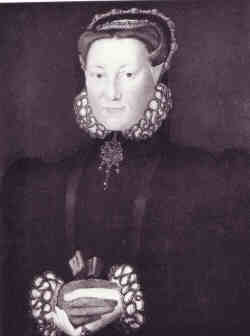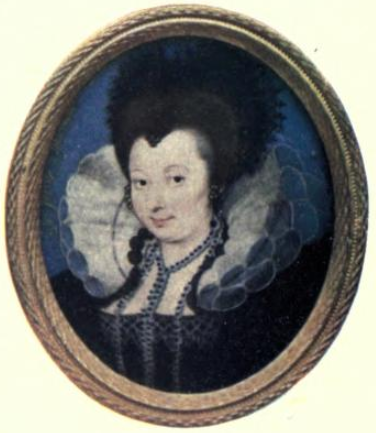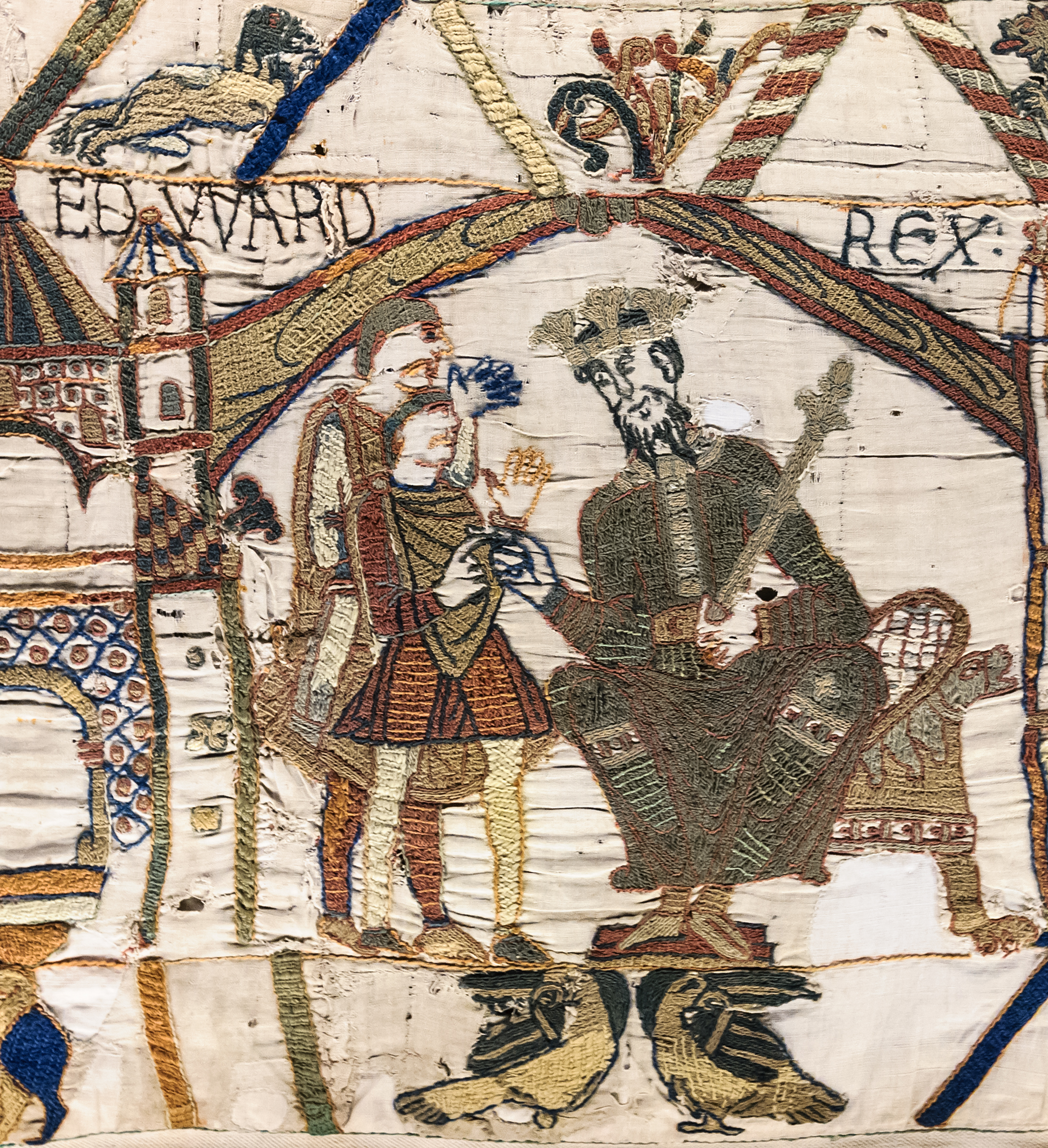|
Margaret Audley, Duchess Of Norfolk
Margaret Howard (née Audley), Duchess of Norfolk (1540 – 9 January 1564) was the sole surviving child of Thomas Audley, 1st Baron Audley of Walden, and Lady Elizabeth Grey, herself the daughter of Thomas Grey, 2nd Marquess of Dorset, and his wife Margaret Wotton. Marriages Margaret was a wealthy heiress and married first, without issue, Lord Henry Dudley, the youngest son of John Dudley, 1st Duke of Northumberland. Her lands were confiscated when her father-in-law was found guilty of treason and executed. In 1556, after her husband had been pardoned, they sued in chancery court to gain back her territory in Hertfordshire, which had been claimed by Thomas Castell. Henry Dudley was killed at the storming of St. Quentin on 27 August 1557. In early 1558, Margaret was betrothed to Thomas Howard, 4th Duke of Norfolk. For the marriage to conform with Catholic canon law, a papal dispensation was required since his first wife, Lady Mary FitzAlan, had been Margaret's first co ... [...More Info...] [...Related Items...] OR: [Wikipedia] [Google] [Baidu] |
Hans Eworth
Hans Eworth (or Ewouts; ) was a Flemish painter active in England in the mid-16th century. Along with other exiled Flemings, he made a career in Tudor London, painting allegorical images as well as portraits of the gentry and nobility.''Concise Grove Dictionary of Art'', "Hans Eworth". About 40 paintings are now attributed to Eworth,Cooper, "Hans Eworth: Four case studies of painting methods and techniques" among them portraits of Mary I and Elizabeth I. Eworth also executed decorative commissions for Elizabeth's Office of the Revels in the early 1570s. Career Nothing is known of Eworth's early life or training. As ″Jan Euworts″, he is recorded as a freeman of the artists' Guild of St Luke in Antwerp in 1540. A ″Jan and Nicholas Ewouts, painter and mercer″ were expelled from Antwerp for heresy in 1544 and scholars generally accept that this Jan is the same individual.Hearn pp. 63–64 By 1545 Eworth was resident in London, where he is well recorded (under a wide v ... [...More Info...] [...Related Items...] OR: [Wikipedia] [Google] [Baidu] |
Elizabeth I Of England
Elizabeth I (7 September 153324 March 1603) was List of English monarchs, Queen of England and List of Irish monarchs, Ireland from 17 November 1558 until her death in 1603. Elizabeth was the last of the five House of Tudor monarchs and is sometimes referred to as the "Virgin Queen". Elizabeth was the daughter of Henry VIII and Anne Boleyn, his second wife, who was executed when Elizabeth was two years old. Anne's marriage to Henry was annulled, and Elizabeth was for a time declared Royal bastard, illegitimate. Her half-brother Edward VI ruled until his death in 1553, bequeathing the crown to Lady Jane Grey and ignoring the claims of his two half-sisters, the Catholic Church, Catholic Mary I of England, Mary and the younger Elizabeth, in spite of Third Succession Act, statute law to the contrary. Edward's will was set aside and Mary became queen, deposing Lady Jane Grey. During Mary's reign, Elizabeth was imprisoned for nearly a year on suspicion of supporting Protestant reb ... [...More Info...] [...Related Items...] OR: [Wikipedia] [Google] [Baidu] |
Church Of St John Maddermarket
The Church of St John the Baptist, Maddermarket, is a redundant Anglican church in the city of Norwich, Norfolk, England. It is recorded in the National Heritage List for England as a designated Grade I listed building, and is in the care of the Churches Conservation Trust. History There may have been a church on the site in the 11th century, but the earliest fabric in the present church dates from the 14th century. Most of the church dates from a major rebuilding between about 1445 to 1510. At some time the east end of the church was shortened. There has been a tradition that this took place in 1578 when the street was widened for a visit by Elizabeth I, but this is considered to be untrue. Following this, the major changes were to the interior of the church. At some time a medieval chancel screen was removed. In 1849 a gallery was installed at the west end. Restorations took place in the 19th century; these included rebuilding the tower in 1822, and ... [...More Info...] [...Related Items...] OR: [Wikipedia] [Google] [Baidu] |
Elizabeth Leyburne
Elizabeth Leyburne, Duchess of Norfolk (1536 – 4 September 1567), was a member of the English nobility. She first married Thomas Dacre, 4th Baron Dacre; following his death in 1566, she secretly married Thomas Howard, 4th Duke of Norfolk. She was his third wife. Family Elizabeth was born in 1536, the daughter of Sir James Leyburn of Cunswick, Westmorland, and his wife Helen Preston. The latter was the child of Thomas Preston and Anne Thornburgh. She had one sister, Anne, who married William Stanley, 3rd Baron Monteagle, by whom there was a daughter, Elizabeth. Several members of the Leyburne (also written as Leybourne and Leyburn) family were recusants, and James Leyburn, Elizabeth's great-nephew, was executed as "a catholic traitor" in 1583. Marriages and issue Elizabeth married twice. She married her first husband, Thomas Dacre, 4th Baron Dacre of Gilsland in 1555. The marriage produced five children: * Francis Dacre (d. an infant) * Anne Dacre (21 March 1557- 19 April 1630 ... [...More Info...] [...Related Items...] OR: [Wikipedia] [Google] [Baidu] |
Thomas Dacre, 4th Baron Dacre
Thomas Dacre, 4th Baron Dacre of Gilsland, 8th Baron Greystoke (''ca.'' 1527 – 1 July 1566) was an Kingdom of England, English Member of Parliament and after his father's death a peerage of England, peer and major landed gentry, landowner in the Ancient counties of England, counties of Cumberland, Yorkshire and Northumberland. Early life Born about 1527, Dacre was the eldest of the five sons of William Dacre, 3rd Baron Dacre (''c.'' 1493 – 1563), by his marriage to Elizabeth Talbot, a daughter of George Talbot, 4th Earl of Shrewsbury and of Anne Hastings, Countess of Shrewsbury, Anne Hastings, a daughter of William Hastings, 1st Baron Hastings. His father was Captain of Norham Castle, Steward of Penrith, Cumbria, Penrith, Warden of the West Marches 1527–1534 and 1555–1563, and List of Governors of Carlisle, Governor of Carlisle. Ferguson's ''A History of Cumberland'' notes the demise of the Dacre family which followed: After Dacre's death on 1 July 1566, his widow r ... [...More Info...] [...Related Items...] OR: [Wikipedia] [Google] [Baidu] |
Castle Howard
Castle Howard is a stately home in North Yorkshire, England, within the civil parish of Henderskelfe, located north of York. It is a private residence and has been the home of the Carlisle branch of the Howard family for more than 300 years. Castle Howard is not a fortified structure, but the term "castle" is sometimes used in the name of an English country house that was built on the site of a former castle. The house is familiar to television and film audiences as the fictional "Brideshead", both in Granada Television's 1981 adaptation of Evelyn Waugh's ''Brideshead Revisited'' and in a two-hour 2008 adaptation for cinema. Today, it is part of the Treasure Houses of England group of heritage houses. History In 1577, the 4th Duke of Norfolk's third son, Lord William Howard, married his step-sister Elizabeth Dacre, youngest daughter of the 4th Baron Dacre. She brought with her the sizable estates of Henderskelfe in Yorkshire and Naworth Castle in what was then Cumberl ... [...More Info...] [...Related Items...] OR: [Wikipedia] [Google] [Baidu] |
Naworth Castle
Naworth Castle, also known or recorded in historical documents as "Naward", is a castle in Cumbria, England, near the town of Brampton. It is adjacent to the A69, about east of Brampton. It is on the opposite side of the River Irthing to, and just within sight of, Lanercost Priory. It was the seat of the Barons Dacre and is now that of their cognatic descendants, the Earls of Carlisle. It is a Grade I listed building. History The castle is thought to have late 13th-century origins, in the form of a square keep and bailey. It was first mentioned in 1323, and in 1335, a licence to crenellate was granted to Ralph Dacre. Thomas Dacre (1467–1525), who commanded the reserve of the English army at the Battle of Flodden and was known as "the Builder Dacre", built the castle's gateway and placed over it his coat of arms with the Dacre family motto below: ''Fort en Loialte'' (Norman-French: "Strong in Loyalty"). It is likely that the 18th-century walled garden lies within the bou ... [...More Info...] [...Related Items...] OR: [Wikipedia] [Google] [Baidu] |
Robert Sackville, 2nd Earl Of Dorset
Robert Sackville, 2nd Earl of Dorset (1561–1609) was an English aristocrat and politician, with humanist and commercial interests. Life He was the eldest son of Thomas Sackville, 1st Earl of Dorset, by Cecily, daughter of Sir John Baker. His grandfather, Sir Richard Sackville, invited Roger Ascham to educate Robert with his own son, an incident in 1563 that Ascham introduced into his pedagogic work ''The Scholemaster'' (1570) as prompting the book. His tutor Claudius Hollyband dedicated to him the French language manuals ''The French Schoolemaster'' (1573) and ''The Frenche Littelton'' (1576), which would see a combined total of fifteen editions through the year 1609. He matriculated from Hart Hall, Oxford, on 17 December 1576, and graduated B.A. and M.A. on 3 June 1579; it appears from his father's will that he was also at New College. He was admitted to the Inner Temple in 1580 but not called to the bar, and was elected to the House of Commons in 1585 as member for S ... [...More Info...] [...Related Items...] OR: [Wikipedia] [Google] [Baidu] |
Katherine Knyvet
Katherine (or Catherine) Knyvett, Countess of Suffolk (1564–1638) was an English court office holder who served as lady-in-waiting to the queen consort of England, Anne of Denmark. Private life She was born in Charlton Park, Wiltshire, the oldest child of Sir Henry Knyvet and his wife Elizabeth Stumpe. Her uncle was Sir Thomas Knyvet, who foiled the gunpowder plot.Early in her life, she married Richard Rich, son of Robert Rich, 2nd Baron Rich, and grandson of Richard Rich, 1st Baron Rich. After his death in 1580 she then married Sir Thomas Howard, who twenty years later was named the Earl of Suffolk. On the death of her father in 1598 she inherited Charlton Park, Wiltshire, which thereafter became the seat of the Earls of Suffolk. Courtier Howard gained a place in Queen Elizabeth's bedchamber and the title of Keeper of the Jewels in 1599. She continued to hold comparable positions after the Union of the Crowns in the reign of James VI and I. On 8 June 1603 King James se ... [...More Info...] [...Related Items...] OR: [Wikipedia] [Google] [Baidu] |
Kenninghall
Kenninghall is a village and civil parish in Norfolk, England, with an area of and a population of 950 at the 2011 census. It falls within the local government district of Breckland. Home to the kings of East Anglia, after the Norman invasion of 1066 William the Conqueror granted the estate to William of Albany and his heirs as a residence for the Chief Butler of England. Origin of the name It has been claimed that the name Kenninghall comes from the Saxon word ''Cyning'' (king) and ''Halla'' (palace), but this is debated, with other writers deriving it from the personal name "Cyna" and the Old English "hala", a clearing in the woods. In maps of the Elizabethan period the house is shown as 'Keningal'. History In the reign of Henry VIII, the estate was granted to Thomas Howard, 2nd Duke of Norfolk, who destroyed the original structure and erected a magnificent new building with two fronts. The house and estate passed to Thomas Howard, 3rd Duke of Norfolk. The estate was confisc ... [...More Info...] [...Related Items...] OR: [Wikipedia] [Google] [Baidu] |
Westminster Abbey
Westminster Abbey, formally titled the Collegiate Church of Saint Peter at Westminster, is an historic, mainly Gothic church in the City of Westminster, London, England, just to the west of the Palace of Westminster. It is one of the United Kingdom's most notable religious buildings and since Edward the Confessor, a burial site for English and, later, British monarchs. Since the coronation of William the Conqueror in 1066, all coronations of English and British monarchs have occurred in Westminster Abbey. Sixteen royal weddings have occurred at the abbey since 1100. According to a tradition first reported by Sulcard in about 1080, a church was founded at the site (then known as Thorney Island) in the seventh century, at the time of Mellitus, Bishop of London. Construction of the present church began in 1245 on the orders of Henry III. The church was originally part of a Catholic Benedictine abbey, which was dissolved in 1539. It then served as the cathedral of the Dioce ... [...More Info...] [...Related Items...] OR: [Wikipedia] [Google] [Baidu] |
St Edward's Crown
St Edward's Crown is the centrepiece of the Crown Jewels of the United Kingdom. Named after Saint Edward the Confessor, versions of it have traditionally been used to crown English and British monarchs at their coronations since the 13th century. The original crown was a holy relic kept at Westminster Abbey, Edward's burial place, until the regalia were either sold or melted down when Parliament abolished the monarchy in 1649, during the English Civil War. The current St Edward's Crown was made for Charles II in 1661. It is solid gold, tall, weighs , and is decorated with 444 precious and semi-precious stones. The crown is similar in weight and overall appearance to the original, but its arches are Baroque. After 1689, it was not used to crown any monarch for over 200 years. In 1911, the tradition was revived by George V and has continued ever since. In 1953, Elizabeth II opted for a stylised image of this crown to be used on coats of arms and other insigni ... [...More Info...] [...Related Items...] OR: [Wikipedia] [Google] [Baidu] |









